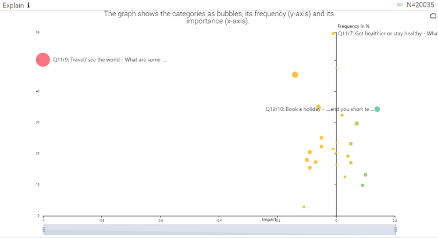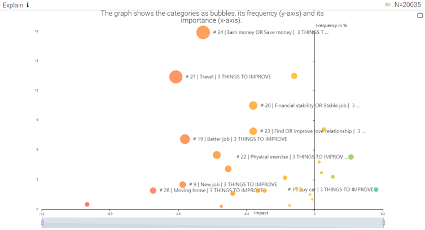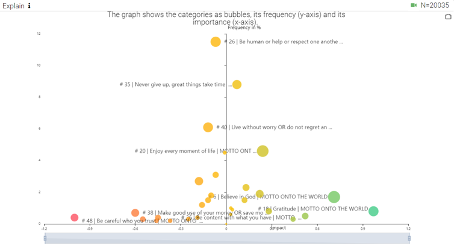The hidden key to happiness
Practice gratitude - day in day out. Try to trust more and forgive.

Article series
Qualitative methods
- Safety and (dis)comfort in qualitative research
- Predictive qual
- Insight communities – hidden depths
- Brand ethics in pandemic time
- The hidden key to happiness
- Identity conflict
- Sales and market research
- Practising empathy
- Market research vs. UX research
- What do the futures of quant and qual methodologies hold?
- Social listening has a long way to go
- What I learned in my first 6 months as a market researcher
- Asking questions that will inspire more transformative insights
- Challenges of qualitative research today - Part 1
- Welcome to the Twatterverse!
- Challenges of qualitative research today - Part 2
- Best practices in writing a discussion guide
- Experience improvement
- The post-pandemic dominance of CRM and UX research
Spring 2021 KANTAR, the largest market research company globally, reached out to 20,000 citizens in ten countries around the world – USA, Brazil, Canada, Netherlands, Italy, Portugal, France, China, India, Japan. The goal was to ask questions nobody with commercial interest would ever ask. The question about happiness in life naturally emerged as a key question. Plenty of unstructured feedback about what concerns people were gathered. KANTAR asked CX.AI to take this data and uncover hidden drivers of happiness. Here they are.
Truth hides behind facts
Facts do not equal Truth. Example?
People were asked about the things that need to change. They most frequently respond “more money/income/revenue”. This is a fact.
People were asked about their motto for life. Most frequently, they respond “be a human, help or respect one another”. This is a fact too.
People were asked about their long-term goals. Most frequently, they respond, “stay healthy or get healthier”. Even this is a fact.
But none of that is the truth. The truth is that none of those facts play an important role in explaining what makes people happy.
We all have an unconscious tendency to jump from fact to conclusion and from correlation to causation. Managers, as well as researchers, do it day in day out.
Facts are just data that needs analysis to find the link between what is happening and the IMPACT on happiness.
It's not enough to ask closed or open questions. This only delivers data.
The same happens in Customer Experience Measurement. Companies ask for the likelihood to recommend and the open-ended question “why”. These programs just give data and facts but no impactful insights (=truth).
AI helps to uncover the hidden truth
Imagine you have data about an outcome you like to improve. Be it customer satisfaction, likelihood to recommend, likelihood to purchase a product concept, amazon rating, or in our case, happiness in life.
Then you have more data about the person but at least an open question about possible reasons that may influence the outcome.
How useful and universal would it be if we could take those data, pour it into an AI that then helps find what best drives results.
We evolve this concept in three steps
1. A deep learning text analytics AI is trained by a human coder. This gives double predictive power over conventional text analytics systems. We deploy the Caplena.com platform.
2. A causal machine learning software models nonlinear and indirect effects and considers driver interactions. It typically results in double explanation power to conventional key driver analysis. We deploy the Neusrel.com platform.
3. Results are fed into an interactive dashboard that enables real-time simulations and predictions.
So now, let’s look at the results. Here is the ultimate question on the outcome we are looking for:
‘How happy are you feeling with your life in general currently?’
We discuss drivers in 3 areas: impact of goals, the impact of problems, and impact of the attitude to life.
The total model achieved an explanation power of .40 and more than doubled the performance of conventional key driver analysis with .18.
Before we dive into this, let’s look at an astonishing finding:
Woman are suffering
The average happiness rating of men and women is roughly the same. But this is just a FACT, not the TRUTH.
The causal machine learning is looking at all explanation information. It finds that being a woman leads to a .76 lower score (on a 10 point scale), if everything else is the same.
Women do some things to keep up. But something about what it means to be a woman in our society is not measured by the survey data and affects their happiness.
Area #1 – Long-term and short-term goals
The survey asked, “What are some of your long-term goals? ....and you short term goals” and provided a multiple-choice list of 27 things to choose from.
Take a deep breath and look at the key drivers canvas that plots the topics on a graph with the frequency mentioned on the Y and the causal impact on the X-axis.
These are the goals that make them happy and unhappy right now.
Around 50% have the long-term goal to travel the world. This goal does not fit in with the current pandemic and means that 50% suffer immensely. It is the single most impactful reason for unhappiness today.
People with this long-term goal would answer on average nearly three scale points less (if everything else were the same).
The anticipation of a holiday in the short term provides relief instead.
To me, the findings reveal the so far underestimated importance of freedom and happiness and thus mental health. This is particularly interesting for countries that tend to lock in their citizens much more than others.
With some data matching to this study, we could easily measure the impact of this fact on higher mortality as it is known that lower happiness leads to mental and physical illness and death.
Again, respondents' most often mentioned goal was to keep or improve health, but this goal seems to be a new platitude - an instant association that evolved during the pandemic.

#2 Things to improve
The second scheme is all around this question ‘Can you think of 3 things that would improve the quality of your life right now?’
As a result, earning money is common and important. The aspiration for more money is a predictor of unhappiness.
But getting a better or new job is not as common and hence even more important. The aspiration to improve the work environment is an even larger predictor of unhappiness.
The intention to do more physical exercises as well as to buy a new car is an indicator of wellbeing as the impact of those indicators is somewhat positive.
This means people neither buy a car nor go to the gym to fix a problem they have.

#3 General attitude to life
Lastly, we integrated information about the attitude to life in the model. It seemed plausible that not just the external challenges but the internal attitude is essential to gain happiness. The exact question posed was:
‘What would be your motto or one piece of advice you would want to pass onto the world?’
Most respondents mention mottos like:
Be a human, help or respect others
Never give up; great things take time
Live without worry
Enjoy every moment in life.
But none of those motto's have a significant impact on happiness.
Instead, what makes people happy is a deeply routed attitude and habit of GRATITUDE. ‘Belief in god’ is also impactful and naturally overlaps with gratitude, a core part of religious practices.
In contrast, what makes people unhappy are limiting, and distrustful beliefs like ‘Be careful who you trust’ and ‘make good use of your money / save money’

The hidden formula for a happy life
This simple formula of happiness has been extracted out of 156 potential explanatory factors. It’s a common theme across 20,000 people from 10 countries. It explains nearly 40 percent of why someone are happy with life:
“Practice gratitude - day in day out. Try to trust more and forgive. Don’t care about money too much, let it go, invest in the now. Choose the right job. Switch to something you are passionate about. Most importantly, try to find peace in substituting traveling-the-world with creative regional travel plans.’
The exercise revealed another finding which can benefit any business:
It's not enough to look at facts or to correlate drivers and outcomes. It is even dangerous.
Instead, the study is living proof of how powerful a proper analysis can be.
Imagine this methodology is run on your CX feedback, brand, or product testing data? How much more impactful could your business initiatives be, how much more successful could your new products become?
Simply by using better the data you already have.
Interested in hearing more?
Dr. Frank Buckler
Founder & CEO at Success DriversArticle series
Qualitative methods
- Safety and (dis)comfort in qualitative research
- Predictive qual
- Insight communities – hidden depths
- Brand ethics in pandemic time
- The hidden key to happiness
- Identity conflict
- Sales and market research
- Practising empathy
- Market research vs. UX research
- What do the futures of quant and qual methodologies hold?
- Social listening has a long way to go
- What I learned in my first 6 months as a market researcher
- Asking questions that will inspire more transformative insights
- Challenges of qualitative research today - Part 1
- Welcome to the Twatterverse!
- Challenges of qualitative research today - Part 2
- Best practices in writing a discussion guide
- Experience improvement
- The post-pandemic dominance of CRM and UX research


